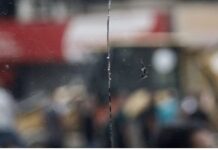Omar Zahzah
Mondoweiss / July 7, 2024
Big Tech’s control over social media has made it a site of censorship and repression, but since October 7 it has also grown as an important tool for resistance.
A particular image has been making the rounds on social media lately. The publication date is not October, but April 2023, and it was taken not from Gaza, but the West Bank. Apparently recirculated on June 13, 2024 by the account @tamerqdh on X (formerly Twitter,) the image shows a Zionist occupation forces soldier posing with a bound and blindfolded female Palestinian hostage. @tamerqdh’s Arabic Tweet thread explains that the photo was self-published on Instagram, where the soldier initially went by or.hazann before changing her name, deleting her profile photo and, as some commenters reveal, going private (all possibly due to the public scrutiny generated by the photo’s virality.)
The Palestinian hostage is in a state of total precarity in the image, immobilized and prevented from seeing, and relegated to the background. The occupation forces soldier dominates the bulk of the frame, a careless, even irreverent attitude on proud display vis-à-vis a silly grimace on her face and both hands held up in “rock and roll” gestures.
These contrasts clarify the colonial and racialized dynamics of the scene, dynamics that appear so self-evident they almost automatically demand connections be made across interlocking contexts of imperial and colonial violence and humiliation.
And social media users were quick to oblige: Australian comedian Aamer Rahman Tweeted an altered version of the image on X that featured a side-by-side comparison with another image showing former US soldier Sabrina Harman posed, smiling and flashing a thumbs-up pose next to a charred corpse. That second image is taken from a lengthy New-Yorker write-up on Harman’s photographs and participation in the sexualized torture and humiliation of Iraqi prisoners at Abu Ghraib during the imperialist invasion and occupation of Iraq that the US undertook as part of its so-called “War on Terror.” “Harman like to have her own picture taken, almost always showing the same smile and thumbs-up sign, whatever the context,” reads the intact photo caption from the New Yorker piece. Rahman’s own status reads, “1) Palestinian woman kidnapped from the West Bank, 2023. 2) Abu Ghraib prison, 2003. In cultures built on supremacy, violence and dehumanization become games.”
“Imperial feminism,” Jairo Fúnez-Flores wrote in a repost of Rahman’s visual remix. “One of the things about social media is that it has completely normalized the Abu Ghraib-style barbarism that Israeli soldiers produce on the daily,” X user @still_oppressed wrote, reposting a Tweet by Motasem A Dalloul with @tamerqdh’s image and the original caption, “April 2023 Israeli soldier takes picture and publishes it showing a female Palestinian hostage kidnapped from the occupied #West_Bank!”
Of course, the generative quality of the image and its circulation exhibit connections with the U.S. military’s proudly documented torture of Iraqi prisoners makes sense. On a basic level, both Harman and the occupation forces soldier voluntarily kept visual records of their abuse. The ease with which such records could be made and, in the case of the occupation forces soldier, even displayed to the world without a second thought is only fully explainable by a degree of dehumanization so thorough that the perpetrator thinks nothing of their present actions and even feels entitled to a continuous social and political reception in which they can be read as nothing more than harmless fun.
Which brings me to the second point: as products of such expectations, Harman’s images and the occupation forces soldier’s photo are evidentiary artifacts of how US imperialism and colonial Zionism jointly gamify and incentivize gendered and racialized violence and torture through the collectively dehumanizing construction of “terrorism.” But as @still_oppressed’s Tweet illustrates, there is also a particular character to the IOF’s relationship to social media. Examples abound of IOF soldiers engaging in blatant cruelty and sadism against Palestinians as well as gleefully partaking in the destruction of civilian infrastructure and spouting genocidal rhetoric. A November 2023 TikTok shows an IOF soldier “dedicating” the blowing-up of a building in Gaza to his infant daughter. A December 19th video shared by Andalou English shows IOF soldiers mocking blindfolded and bound Palestinian captives in Jenin as they smoke hookah and eat chips. That same month, as reported by CNN, IOF soldiers filmed themselves on social media burning food and looting private homes in Gaza. “We turn on the light against this dark place and burn it until there is no trace of this dark place,” an IOF soldier burning the food says into the camera. In February, according to Euro Med Monitor, IOF soldiers allowed Israeli civilians to watch and film on their phones as they tortured Palestinian men stripped to their underwear with hot water, metal batons, and electric sticks.
A video posted to X by @MahaGaza on June 12th shows a pair of IOF soldiers playing football and counting down the explosion of a building in Gaza.
“You have nowhere to return to, Gazans,” a different IOF soldier intones to the camera in another video Tweeted by Quds News Network on June 13th. Standing in the rubble of an emptied and bombed out building, the IOF soldier continues, “To all dear Gaza residents, you are not ‘dear,’ you are trash… You will die, you have nowhere to go back to.”
Some have pointed out that this engagement is not new. X user @ireallyhateyou recalled the case of former IOF soldier Eben Abergel, who in 2010 published an album titled “Army… the most beautiful time in my life :)” on Facebook that showed Abergel playfully posing alongside bound and blindfolded Palestinian hostages. Then, as now, connections to Abu Ghraib were made, and Breaking the Silence undertook a campaign to show that posing with captive Palestinians as “trophies” is in fact a widespread IOF practice.
Indeed, it is not the novelty of such depraved behavior that is garnering increasing scrutiny, but its pervasiveness. Zionists broadcast a full spectrum of deprivation and dehumanization of Palestinians, from the spectacular to the mundane, with a violent arrogance and narcissistic entitlement reflecting the collective aspirations of Zionism as a settler-colonial, imperial, and genocidal enterprise.
Compare this to the Palestinian resistance: while Zionist occupation forces take to social media to broadcast their sadism and destruction of civilian infrastructure, resistance groups such as Hamas repurpose the internet and digital platforms such as Telegram in such a way as to continuously erode the image of Israeli military impunity. In an undated and now viral video, Al-Qassam brigades military spokesman Abu Obeida mocks the occupation forces for wearing diapers, “specifically pampers,” and being afraid “to come down to the battlefield to face [real] men.” Demeaning the IOF for their avoidance of direct confrontation, the jibe blends insult with military critique. Self-released videos display targeted operations as well as increasing munitions capabilities. Reflecting on Ha’aretz military correspondent Amos Harel’s observation that Israeli forces have been largely unable to significantly offset Hamas’ command and control, Saree Makdisi writes, “Anyone watching the videos of daring Palestinian close-quarters attacks on Israeli troops and armor on Al Jazeera Arabic could have come up with the same assessment.”
The disparity between the resistance’s military focus and sophistication and the occupation forces’ indiscriminate violence and cruelty has not gone unnoticed. “Bro seriously look at the heroic shit Palestinian fighters are doing, putting bombs on tanks barehanded and shooting drones out the sky. Compare that to how the IOF is bombing schools and hospitals. Who deserves condemnation here?” X user @killerguerilla tweeted on November 4, 2023. In Lebanon, after Hizbullah downed Israel’s Hermes 900 drone and launched a Volcano missile at the Gabor military camp in the Kiryat Shmona settlement on June 1, Israel bombed a house in Siddiqine, injuring 6 people. Assessing the dynamic, Louis Allday tweeted, “The contrast is so stark and obvious – Hizbullah is consistently targeting and destroying military infrastructure, and Israel targets civilians in their cars and homes.” The divide between the resistance’s military precision and the colonizer’s collective punishment abounds, endures, and expands in online spaces, digitally detailing the structural and political chasm between the violence of the colonizer and the subjugation, as well as the targeted resistance of the colonized.
I have used the phrase digital/settler-colonialism to refer to the meeting point between oligarchic Big Tech hegemony and Zionist settler-colonialism. At the same time, while social media has become an increasingly embattled site of repression concerning Palestine, I believe it’s important to resist fatalism. In his reflections on the social and political functions of television, literary critic Raymond Williams wrote that even as we resist technological determinism, “we must be careful not to substitute for it the notion of a determined technology” (133.) Technology does not—indeed, cannot—purely facilitate the dictates of elite control, ensuring all of its desired effects. The viewers of television, which underwent commercial capture even as it was never completely shorn of military and political purposes, were a case in point: “To controllers and programmers they might seem merely objects: a viewing public or market. But from their own side of the screen there was a different perspective: if they were exposed by need in new ways, they were also exposed to certain uncontrollable opportunities. This complicated interaction is still very much in the process of working itself out” (134.)
However domination might attempt to curtail them, such “uncontrollable opportunities” are ultimately fundamental to the process of popular interaction with new technologies, and this dynamic has crucial implications for anti-colonial struggle. In “This is the Voice of Algeria,” Frantz Fanon reveals how the FLN strategically appropriated and re-deployed the radio, which began as an instrument of French colonial domination and class hierarchy, as a tool to concentrate and galvanize morale among colonized Algerians. Launching the program Voice of Fighting Algeria at a moment when the liberation struggle was in the ascendant turned the radio, which began “as a symbol of French presence, as a material representation of the colonial configuration” (3) into a device through which “Every Algerian felt himself to be called upon and wanted to become a reverberating element of the vast network of meanings born of the liberating combat” (14.) The resistance’s savvy and intentional use of digital media today to undermine the hegemonic image of the colonial Zionist military as an impenetrable and ethical force is a continuation of this particular tendency. That it connects to and exacerbates the unwitting self-incrimination of occupation forces at a broader moment of increasing global rejection of Zionist settler-colonial violence manifesting in genocide reflects the unpredictable potential of social media even amidst an atmosphere of increasing repression. And this is a potential born of the capacity for all technologies not only to mediate social and political life, but also to capture and reflect emerging currents of belief.
To that end, despite its domination by imperialist and capitalist forces, social media unwittingly serves to illuminate the colonial contours of the Palestinian liberation struggle. Pro-genocide and pro-colonial elites will most likely continue to further their mechanisms of suppression. Indeed, some Hamas channels have been restricted on versions of Telegram downloaded from Google Play or Apple’s App Store following a letter sent to Apple on October 25, 2023 by the Zachor Legal Institute, a Zionist, anti-BDS lobbying organization whose previous claims to fame include spearheading a campaign to block financial services to the Alliance for Global Justice (AFGJ) for supporting Samidoun Palestinian Prisoner Solidarity Network as well as filing a complaint with the Department of Education alleging Students for Justice in Palestine (SJP) is a “terror front” and that UCLA was committing “an intentional act of antisemitism” by allowing the 2018 National Students for Justice in Palestine conference to proceed on its campus.
Google and Apple’s move to stifle the resistance’s access to digital pathways in accordance with the dictates of Zionist colonization is a clear example of digital/settler-colonialism at work. But they can’t delete the broader ethical momentum upon which the resistance, using the most up to date tools, has seized upon so impeccably. For it is a momentum arising from the surety that, for all of the death and dispossession, the colonial Zionist state must fall, and Palestine must—and will—be free.
Omar Zahzah is a writer, poet, organizer, and Assistant Professor of Arab and Muslim Ethnicities and Diasporas (AMED) Studies at San Francisco State University; Omar’s book, Terms of Servitude: Zionism, Silicon Valley, and Digital/Settler-Colonialism in the Palestinian Liberation Struggle is forthcoming from The Censored Press in Fall 2025












